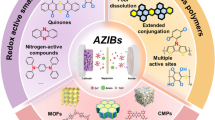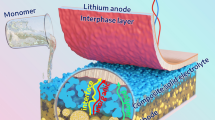Abstract
Owing to the merits of environmental friendliness and sustainability, aqueous zinc ion battery (AZIB) is considered as a promising energy storage system. Nevertheless, the further application of AZIB is largely limited by the growth of zinc dendrite and hydrogen evolution reaction of Zn anode. Here, a β-polyvinylidene fluoride (β-PVDF) nanofiber modified by 1-butyl-3-methyl imidazolium trifluoromethane sulfonate coating layer was prepared to tackle the problem of Zn anode. The artificial β-PVDF can restrict HER and provide driving force to accelerate the migration of Zn2+ at electrolyte/Zn interface, which enables uniform and compact Zn deposition. And the symmetric cell with polymer-coating-layer-modified Zn anode demonstrates a long cycle for 1000 h at 2 mA cm−2. Moreover, the artificial β-PVDF nanofiber layer achieves a very low polarization voltage of about 50 mV even if the current density gradually increases to 10 mA cm−2. Consequently, the β-PVDF/BMI@Zn||MnO2 full cell reaches a high specific capacity of 186 mAh g−1 after 1600 cycles at 1 A g−1. This work provides a new possibility for the realization of high performance Zn anode.
Graphical abstract









Similar content being viewed by others
References
Jia X et al (2020) Active materials for aqueous zinc ion batteries: synthesis, crystal structure, morphology, and electrochemistry. Chem Rev 120(15):7795–7866. https://doi.org/10.1021/acs.chemrev.9b00628
Li M et al (2018) 30 years of lithium-ion batteries. Adv Mater 30:1800561. https://doi.org/10.1002/adma.201800561
Sun YY et al (2022) A review of interfaces within solid-state electrolytes: fundamentals, issues and advancements. Chem Eng J 437:135179. https://doi.org/10.1016/j.cej.2022.135179
Lin D et al (2017) Reviving the lithium metal anode for high-energy batteries. Nat Nanotechnol 12:194–206
Naveed A et al (2022) Revisiting recent and traditional strategies for surface protection of Zn metal anode. J Power Sources 525:231122. https://doi.org/10.1016/j.jpowsour.2022.231122
Yi Z et al (2020) Strategies for the Stabilization of Zn Metal Anodes for Zn-Ion Batteries. Adv Energy Mater 11(1):2003065. https://doi.org/10.1002/aenm.202003065
Li TC et al (2021) Recent progress in aqueous zinc-ion batteries: a deep insight into zinc metal anodes. J Mater Chem A 9:6013–6028. https://doi.org/10.1039/d0ta09111a
Li CW et al (2022) Roadmap on the protective strategies of zinc anodes in aqueous electrolyte. Energy Storage Mater 44:104–135. https://doi.org/10.1016/j.ensm.2021.10.020
Wang T et al (2020) Anode materials for aqueous zinc ion batteries: mechanisms. Prop Perspect ACS Nano 14(12):16321–16347. https://doi.org/10.1021/acsnano.0c07041
Hu W et al (2021) Recent progress in tackling Zn anode challenges for Zn ion batteries. J Mater Chem A 9:25750–25772. https://doi.org/10.1039/d1ta08184e
Huang J et al (2021) Ultrastable zinc anodes enabled by anti-dehydration ionic liquid polymer electrolyte for aqueous Zn batteries. ACS Appl Mater Interfaces 13:4008–4016. https://doi.org/10.1021/acsami.0c20241
Wang Z, Dong L, Huang W, Jia H, Zhao Q, Wang Y, Fei B, Pan F (2021) Simultaneously regulating uniform Zn2+ flux and electron conduction by MOF/rGO interlayers for high-performance Zn anodes. Nano-micro lett 1:1–1. https://doi.org/10.1007/s40820-021-00594-7
Jin Y et al (2020) Stabilizing zinc anode reactions by polyethylene oxide polymer in mild aqueous electrolytes. Adv Func Mater 30(43):2003932. https://doi.org/10.1002/adfm.202003932
Yang P et al (2020) Thermal self-protection of zinc-ion batteries enabled by smart hygroscopic hydrogel electrolytes. Adv Energy Mater 10(48):202002898. https://doi.org/10.1002/aenm.202002898
Xu WN et al (2019) Diethyl ether as self-healing electrolyte additive enabled long-life rechargeable aqueous zinc ion batteries. Nano Energy 62:275–281. https://doi.org/10.1016/j.nanoen.2019.05.042
Pengchao R et al (2022) Design strategies for high-energy-density aqueous zinc batteries. Angew Chem Int Ed 134(17):e202200598. https://doi.org/10.1002/ange.202200598
Cui B-F et al (2021) Micronanostructured design of dendrite-free zinc anodes and their applications in aqueous zinc-based rechargeable batteries. Small Struct 2(6):2000128. https://doi.org/10.1002/sstr.202000128
Wang M et al (2022) Toward dendrite-free and anti-corrosion Zn anodes by regulating a bismuth-based energizer. eScience 2(5):509–517. https://doi.org/10.1016/j.esci.2022.04.003
Zhang K et al (2020) Electrodeposition accelerates metal-based batteries. Joule 4:10–11. https://doi.org/10.1016/j.joule.2019.12.012
Yang Y et al (2021) Redistributing Zn-ion flux by interlayer ion channels in Mg-Al layered double hydroxide-based artificial solid electrolyte interface for ultra-stable and dendrite-free Zn metal anodes. Energy Storage Mater 41:230–239. https://doi.org/10.1016/j.ensm.2021.06.002
Zeng X et al (2021) Bio-inspired design of an in situ multifunctional polymeric solid–electrolyte interphase for Zn metal anode cycling at 30 mA cm−2 and 30 mA h cm−2. Energy Environ Sci 14(11):5947. https://doi.org/10.1039/d1ee01851e
Zeng X et al (2021) Electrolyte design for in situ construction of highly Zn2+-conductive solid electrolyte interphase to enable high-performance aqueous Zn-ion batteries under practical conditions. Adv Mater 33(11):2007416. https://doi.org/10.1002/adma.202007416
Zhao Z et al (2019) Long-life and deeply rechargeable aqueous Zn anodes enabled by a multifunctional brightener-inspired interphase. Energy Environ Sci 12:1938–1949. https://doi.org/10.1039/c9ee00596j
Chen P et al (2021) An artificial polyacrylonitrile coating layer confining zinc dendrite growth for highly reversible aqueous zinc-based batteries. Adv Sci 8(11):2100309. https://doi.org/10.1002/advs.202100309
Hao J et al (2020) Designing dendrite-free zinc anodes for advanced aqueous zinc batteries. Adv Func Mater 30:202001263. https://doi.org/10.1002/adfm.202001263
Liu S et al (2021) Tuning the electrolyte solvation structure to suppress cathode dissolution, water reactivity, and Zn dendrite growth in zinc-ion batteries. Adv Func Mater 31(38):2104281. https://doi.org/10.1002/adfm.202104281
Jianlong C et al (2020) Ultra-stable and highly reversible aqueous zinc metal anodes with high preferred orientation deposition achieved by a polyanionic hydrogel electrolyte. Energy Storage Mater 35:586–594. https://doi.org/10.1016/j.ensm.2020.11.041
Zou PC et al (2021) Ultrahigh-rate and long-life zinc-metal anodes enabled by self-accelerated cation migration. Adv Energy Mater 11(31):2100982. https://doi.org/10.1002/aenm.202100982
Xiang J et al (2019) A lithium-ion pump based on piezoelectric effect for improved rechargeability of lithium metal anode. Adv Sci 6(22):1901120. https://doi.org/10.1002/advs.201901120
MacFarlane DR et al (2016) Ionic liquids and their solid-state analogues as materials for energy generation and storage. Nat Rev Mater 1:15005. https://doi.org/10.1038/natrevmats.2015.5
Ma LT et al (2020) Hydrogen-Free and Dendrite-Free All-Solid-State Zn-Ion Batteries. Adv Mater 32(14):1908121. https://doi.org/10.1002/adma.201908121
Hieu LT et al (2021) Zn anode with flexible β-PVDF coating for aqueous Zn-ion batteries with long cycle life. Chem Eng J 411:12858. https://doi.org/10.1016/j.cej.2021.128584
Martins P et al (2014) Electroactive phases of poly(vinylidene fluoride): determination, processing and applications. Prog Polym Sci 39:683–706. https://doi.org/10.1016/j.progpolymsci.2013.07.006
Sencadas V et al (2006) Processing and characterization of a novel nonporous poly(vinilidene fluoride) films in the beta phase. J Non-Cryst Solids 352(21–22):2226–2229. https://doi.org/10.1016/j.jnoncrysol.2006.02.052
Wang F et al (2012) Ionic-liquid-induced ferroelectric polarization in poly(vinylidene fluoride) thin films. Appl Phys Lett 100(6):062903. https://doi.org/10.1063/1.3683526
Liu M et al (2019) Artificial solid-electrolyte interface facilitating dendrite-free zinc metal anodes via nanowetting effect. ACS Appl Mater Interfaces 11:32046–32051. https://doi.org/10.1021/acsami.9b11243
Cui Y et al (2020) An interface-bridged organic-inorganic layer that suppresses dendrite formation and side reactions for ultra-long-life aqueous zinc metal anodes. Angew Chem Int Ed 59(38):16594–16601. https://doi.org/10.1002/anie.202005472
Abdel-All MS et al (1992) Inhibiting and accelerating effects of some quinolines on the corrosion of zinc and some binary zinc alloys in HCl solution. J Appl Electrochem 22:1104–1109. https://doi.org/10.1007/bf01029593
Abdallah M (2003) Ethoxylated fatty alcohols as corrosion inhibitors for dissolution of zinc in hydrochloric acid. Corros Sci 45(12):2705–2716. https://doi.org/10.1016/s0010-938x(03)00107-0
Blanc E et al (2020) Scientific Challenges for the Implementation of Zn-Ion Batteries. Joule 4(4):771–799. https://doi.org/10.1016/j.joule.2020.03.002
Zheng J et al (2019) Reversible epitaxial electrodeposition of metals in battery anodes. Science 366(6465):645–648. https://doi.org/10.1126/science.aax6873
Cao J et al (2020) A universal and facile approach to suppress dendrite formation for a Zn and Li metal anode. J Mater Chem A 8:9331–9344. https://doi.org/10.1039/d0ta02486d
Devaraj S et al (2008) Effect of crystallographic structure of MnO2 on its electrochemical capacitance properties. J Phys Chem C 112:4406–4417. https://doi.org/10.1021/jp7108785
Islam S et al (2017) Facile synthesis and the exploration of the zinc storage mechanism of beta-MnO2 nanorods with exposed (101) planes as a novel cathode material for high performance eco-friendly zinc-ion batteries. J Mater Chem A 5:23299–23309. https://doi.org/10.1039/c7ta07170a
Zhang N, Cheng F, Liu J, Wang L, Long X, Liu X, Li F, Chen J (2017) Rechargeable aqueous zinc-manganese dioxide batteries with high energy and power densities. Nat Commun 8(1):1–9. https://doi.org/10.1038/s41467-017-00467-x
Acknowledgements
The authors would like to thank the financial supports from “the National Natural Science Foundation of China” (Grant no. 51673154) and “the Fundamental Research Funds for the Central Universities” (WUT: 2019IVA003).
Author information
Authors and Affiliations
Contributions
XY conception, methodology, experimental design, carrying out measurements and manuscript composition. JY and CL conception, methodology, and writing, reviewing, and editing. ZZ and CX methodology, supervision, formal analysis, visualization, writing, reviewing, and editing, and funding acquisition.
Corresponding authors
Ethics declarations
Conflicts of interest
The authors declare that they have no conflict of interest.
Ethical approval
Human subjects were not involved in this study.
Rights and permissions
Reprints and Permissions.
Additional information
Handling Editor: Naiqin Zhao.
Publisher's Note
Springer Nature remains neutral with regard to jurisdictional claims in published maps and institutional affiliations.
Supplementary Information
Below is the link to the electronic supplementary material.
Rights and permissions
Springer Nature or its licensor (e.g. a society or other partner) holds exclusive rights to this article under a publishing agreement with the author(s) or other rightsholder(s); author self-archiving of the accepted manuscript version of this article is solely governed by the terms of such publishing agreement and applicable law.
About this article
Cite this article
Yuan, X., Yi, J., Li, C. et al. An artificial β-PVDF nanofiber layer for dendrite-free zinc anode in rechargeable aqueous batteries. J Mater Sci 58, 1708–1720 (2023). https://doi.org/10.1007/s10853-023-08139-6
Received:
Accepted:
Published:
Issue Date:
DOI: https://doi.org/10.1007/s10853-023-08139-6




